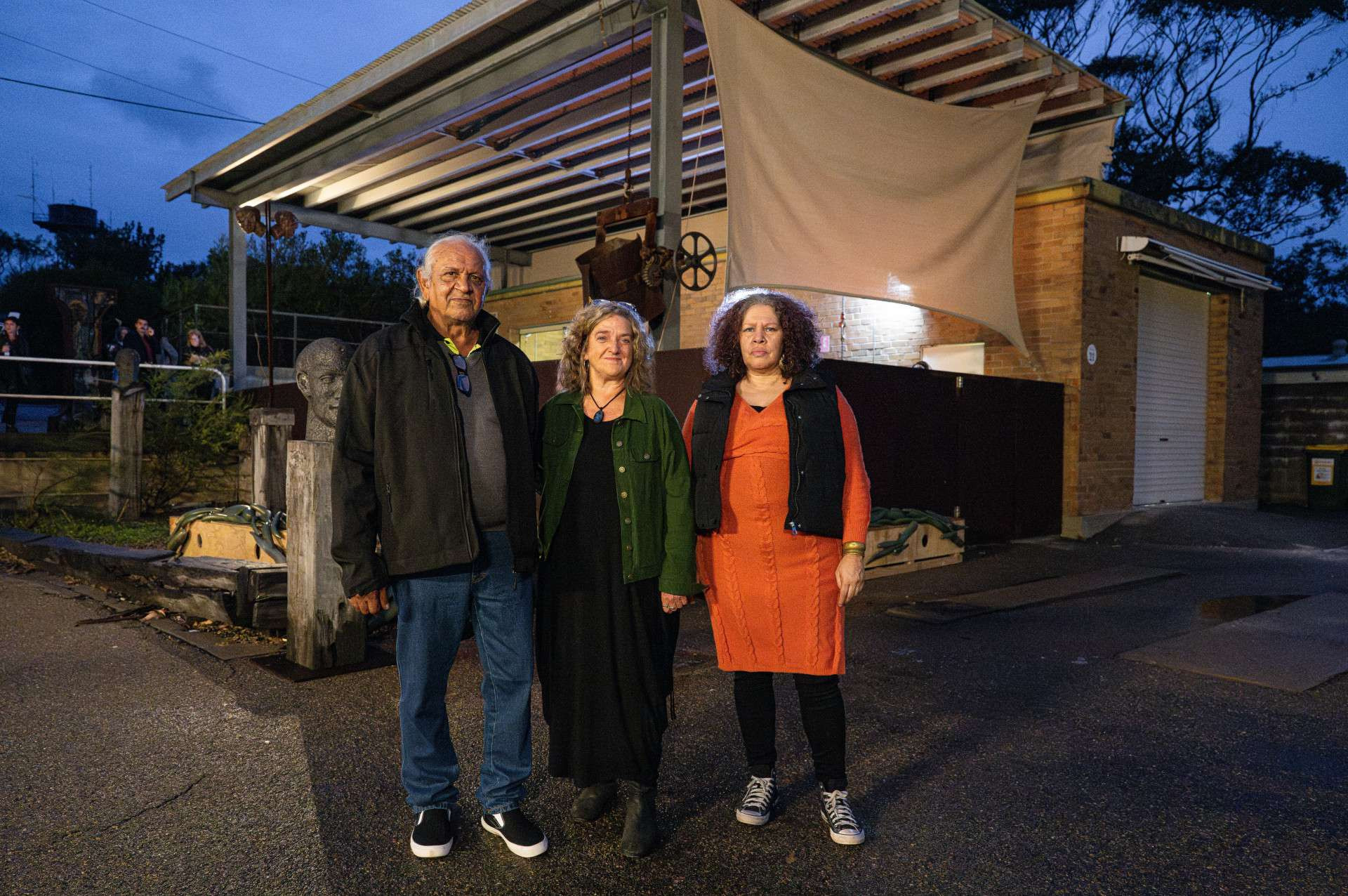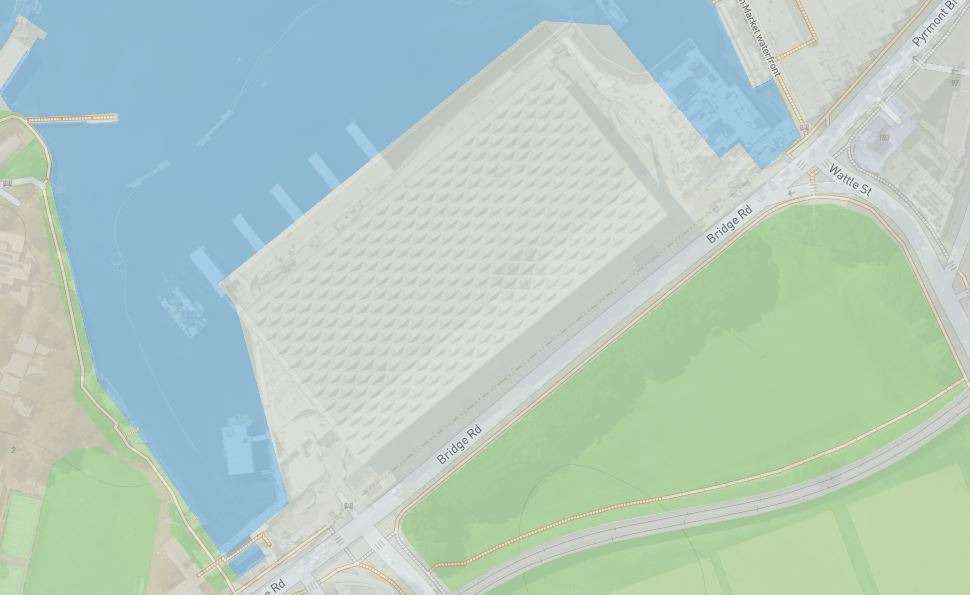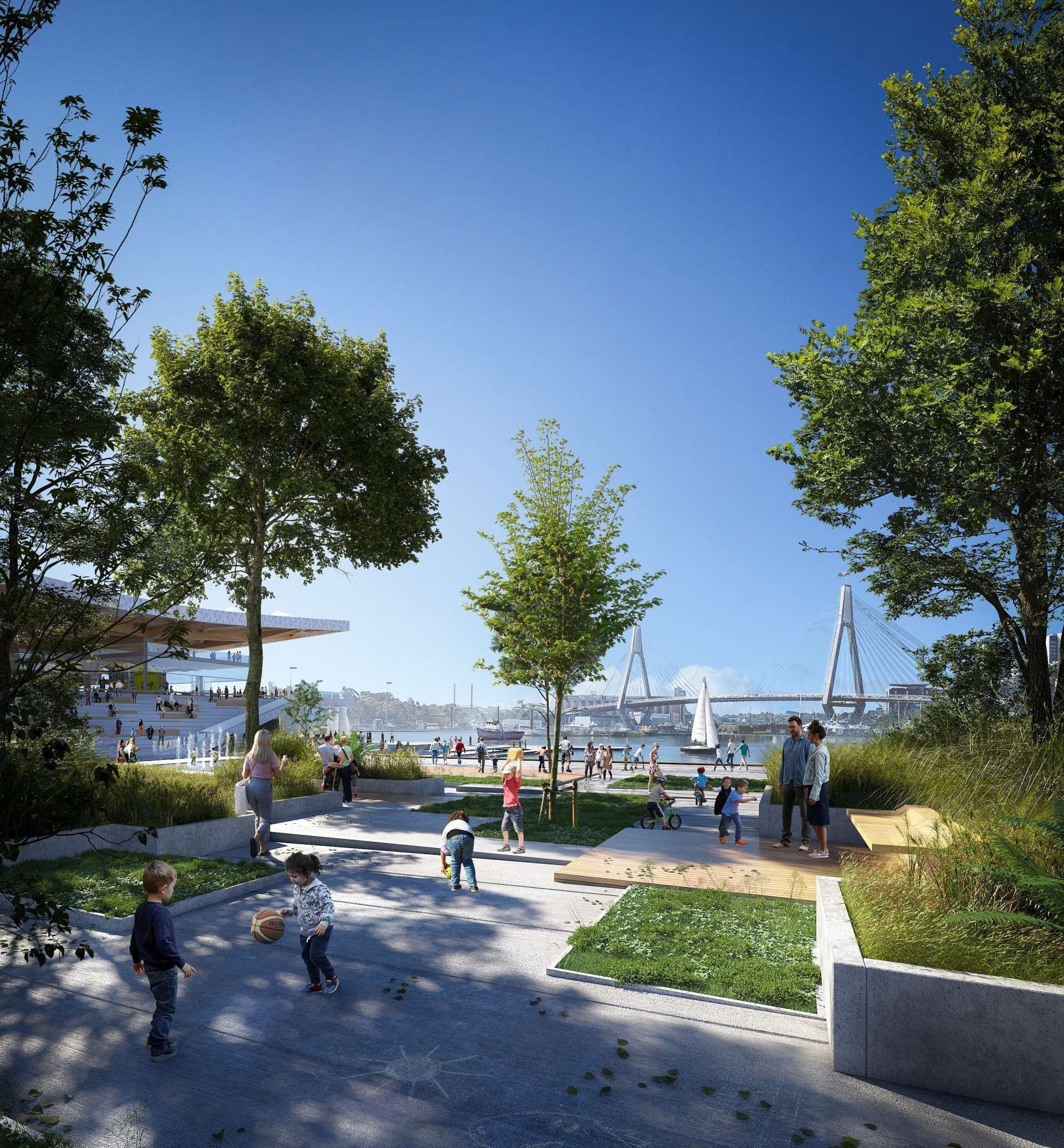Public domain
Public open space
Blackwattle Bay is undergoing a remarkable transformation as one of Sydney’s most significant urban renewal projects. At the heart of this revitalisation is the new Sydney Fish Market, a vibrant hub that blends tradition, innovation, and community.
This new destination will feature over 6,000sqm of public open space including a waterfront promenade that connects to the scenic 15km foreshore walk from Rozelle Bay to Woolloomooloo.

Heritage interpretation
A heritage interpretation program will honour the area’s First Nations heritage and maritime history, offering locals and visitors a meaningful cultural experience when visiting the site.
Five permanent installations that reflect the living stories of past, present, and future will be on the public domain at the new Sydney Fish Market:
Three bronze sculptures on the promenades tell the Saltwater People Stories, paying respect to the continued presence of local Aboriginal people and their ancestral fishing traditions in Blackwattle Bay
An interactive water play area ‘Land of the Giant Pippies’ will be located on the eastern promenade
An installation ‘Coal Loader Palm Grove’ that pays homage to the site’s industrial history will be located on the eastern promenade.
Curated by Sydney-based public arts advisor Cultural Capital and curator Daniel Mudie Cunningham, the program will also feature contemporary performances by both established and emerging artists. Placemaking NSW, as the owner and manager of the public domain will host a curated arts and cultural program featuring dance and music throughout 2026.
Saltwater People Stories
For thousands of years, the Gadigal, one of the many saltwater clans of the Sydney region, have been traditional custodians here, sharing this place and its resources with other neighbouring clans. This area was a popular place for fishing, swimming and gathering. Their deep connection to this place is honoured through three powerful installations:
The Nawi –a traditional bark canoe by Bidjigal elder Uncle Steven Russell
Birrang Narrami (Star Net) – a traditional woven fishing net by Wiradjuri, Yuin and Gadigal multi-disciplinary artist and master weaver Nadeena Dixon
The Call of Ngura (Country) – with eel-like forms representing the Dreamtime journey of the great Creator Gurangady by Buruberong and Wumali (Dharug) creative Leanne Tobin.

Uncle Steven Russell, Leanne Tobin and Nadeena Dixon
The installations
The Nawi by Uncle Steven Russell
Bidjigal Elder, Dharawal-Wodi-Wodi and Birpai Nations
About the artist
Uncle Steven Russell is a Bidjigal artist, master weaver and Cultural Knowledge Holder, hailing from the renowned La Perouse Timbery family.
About the sculpture
Long before a fish market existed at this site, Blackwattle Bay was a bustling hub for collecting seafood. Saltwater People have navigated nawis (traditional Aboriginal bark canoes) through these waters for thousands of years.
Using the same methods of his ancestors, Uncle Steven crafted a traditional stringybark nawi that functions perfectly in the water. This nawi was then cast in bronze, preserving its exact form and detail, to produce the sculpture that will sit on the new Sydney Fish Market foreshore.
Positioned upturned as they once were on these shores, this sculpture revives a presence not seen on these waters for over 150 years.
This commission symbolises the enduring culture and fishing practices of the Saltwater People and their relationship to the land and water where the new Sydney Fish Market sits.
Birrang Narrami (Star Net) by Nadeena Dixon
Gadigal, Yuin, Dharawal, Dharug and Wiradjuri Nations
About the artist
Nadeena Dixon is a multidisciplinary artist and master weaver dedicated to passing her cultural knowledge on to future generations.
About the sculpture
Nadeena presents a traditional woven fishnet, a tool used by the Gadigal at this site for thousands of years. The weaving is knotted with a specific Gadigal technique called the Diamond Net, and suspended between two Gymea Lillies, reflecting traditional ancestral practices.
The title, Birrang Narrami (Star Net), references the strong connection that Gadigal have to the stars. Stars feature in many creation stories and teach people about the creation time and how the stars came to be.
In Gadigal cosmology, it is believed that the sky world is a giant net. The stars also act as a seasonal calendar, telling us when the migratory fish are travelling and able to be caught. Its unfinished form speaks to the ongoing journey of healing and cultural preservation.
The Call of Ngura (Country) by Leanne Tobin
Dharug Nation
About the artist
Leanne Tobin is a multidisciplinary artist of Irish, English and Aboriginal heritage descending from the Buruberong and Wumali clans of the Dharug, the traditional Aboriginal people of the Greater Sydney region.
About the sculpture
Leanne’s sculpture The Call of Ngura (Country) tells a local story of a powerful Creator being known as Gurangady.
Back in the Dreaming, Gurangady, in the form of a giant eel-like serpent, moved across the land forging the valleys, rivers and mountains. The eel is seen as Garrangady’s descendant, known by the local Dharug people as ‘bara’.
Upon maturity, bara emerge from freshwater to prepare for their ocean journey. As they wait for a full moon and high tide, they undergo physical changes before swimming thousands of kilometres to the Coral Sea to spawn and die. Their offspring, called ‘glass eels’, hatch and are carried by currents back to freshwater rivers to begin the cycle again. This ancient cycle continues today and serves as a metaphor, acknowledging the resilience and survival of the bara and the Dharug people.
Ngallawan: We live, we remain.
Locations
The sculptures will be located on the eastern and western promenades:

Land of the Giant Pippies by Alison Page
Dharawal and Yuin Nations
About the artist
Alison Page is a Dharawal and Yuin artist and designer that has a multi-media practice in public art, film, installations and urban design. Her work is centered on finding Country; its memories, voices, stories and knowledges within the urban fabric. It is grounded in the belief that the built environment is an extension of Country and the cultural practices of its custodians preserve, animate and amplify its stories. She has a number of works in the Sydney area including Wellama (2019) a permanent film installation at the Cutaway in Barangaroo, The Eyes of the Land and the Sea (2020), a 30m bronze sculpture in the water at Kamay (Botany Bay), the Acknowledgement of Country Plinth (2024) at the NSW Parliament, and the Burri Burri artwork (2025) at Bondi Pavilion.
About the installation
Authentically integrated within the new Sydney Fish Market’s forecourt landscape design, Land of the Giant Pippies honours the enduring significance of Country through reference to the abundant coastal landscapes of Sydney. The waterplay artwork features large concrete pippi (shellfish) mounds that invite exploration and interaction.
It honours Aboriginal connections to coastal landscapes, referencing traditional fishing practices and cultural knowledge from the artist’s Dharawal and Yuin heritage. The etched pathways on the sculptures mimic the movements of shellfish and the flow of tides, symbolising the living energy of the ocean. Playful and tactile, the work engages visitors—especially children—as vital energy sources that keep the "giant pippies" alive, creating a meaningful link to Country and community.
Location

Coal Loader Palm Grove by Mike Hewson
About the artist
Mike Hewson is a visual artist with a background in structural engineering and heavy-civil construction. His award-winning projects pioneer new ways to merge conceptual art projects into the public realm. Hewson specialises in work that blurs the distinction between art and architecture, with a particular focus on civic spaces.
His current exhibit at the Art Gallery of NSW, The Key’s Under the Mat has transformed the underground Tank space into an interactive park, playground, construction site, and communal space. The installation blends sculpture, architecture, and play, inviting visitors to meet, play, explore, and create in a space built from salvaged materials.
About the installation
Coal Loader Palm Grove provides a contemporary interpretation of the former Blackwattle Bay coal loader which was built in 1926 and worked in this location for part of the 20th century. Elements of coal loader sits among a dense grove of palms, a local indigenous tree species known as Daranggara by the Dharug and Gadigal people which filled many of the valleys along Sydney harbour. They were in dense groves up until the early 1800s before their destruction.
Sydney’s harbour as a working harbour is an important piece of Sydney’s civic narrative. This lens of the working harbour and its industrial history is also a story about trade, globalisation, ecology and the environment.
Location


Creating new public space in Blackwattle Bay
The new Sydney Fish Market creates an exciting opportunity to transform currently inaccessible harbour front land and deliver a variety of new public spaces. This will allow people to access the head of Blackwattle Bay for the first time since industrial uses took over in the 19th century.
More than 6,000 square metres of new public space will include:
The urban park
Waterfront promenade
The local plaza
Bridge Road promenade.